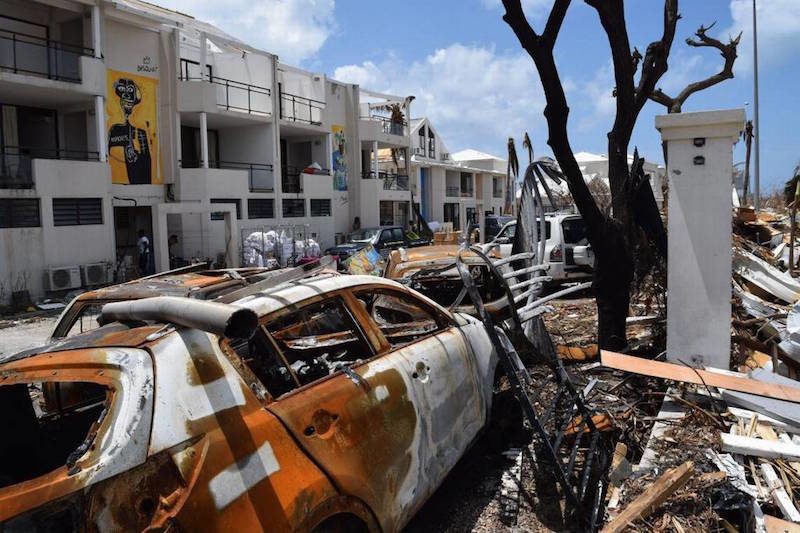
Irma hit the shared Dutch and French Caribbean island as a Category 5 hurricane with winds in excess of 200 miles an hour, turning the picturesque tourist haven into a sweltering trash heap without power, water or communications. What the hurricane didn't steal, looters often did.
On Friday night, Yvanna and Theodore DeWeever - a young married couple - had collapsed onto the deck chairs of Royal Caribbean's Majesty of the Seas that has been running missions of mercy, helping evacuate people from hard-hit Caribbean islands to Puerto Rico.
The couple, both natives of the Dutch side of the island, St. Maarten, said the chaos after the storm was almost as terrifying as the hurricane itself. The hotel where they took shelter was overrun by thieves who tried to break open doors with bricks. People were held up at gunpoint in the lobby, they said.
But what led them to leave the island is the hope that they might be more useful abroad. They're both teachers on an island that no longer has schools. They're hoping to make their way to Toronto and find jobs that will support those staying behind.
"We miss our families, and we've been crying," Theodore said, as the ship's speakers pumped out soft-rock music. "If some of us don't get out, to help from outside, how are we ever going to rebuild?"
In the initial days after the storm, it was unclear if rebuilding was even an option. There were reports and rumors that the desalinization plant and water-storage tanks - keys to life on the island - had been obliterated.
But locals said the plant is working and some tanks remained undamaged. Municipal water, and even some power, has been restored in a few neighborhoods. An influx of Royal Netherlands Marines - distributing drinking water and emergency food rations - has also helped restore order to the island.
But St. Martin's economic lifeblood, tourism, doesn't seem like it will be pumping anytime soon. Streets remain choked with garbage, and hotels and rental properties have been cracked open like dollhouses with their façades removed. At the badly damaged Sonesta Hotel, in St. Maarten, the management was giving away all the furniture - and it was unclear if and when it would be replaced. A parking lot full of dozens of rental cars had been reduced to orderly rows of burned-out hulks.
Carlos De Hernando was staring at a boatyard, where mega-yachts and luxury craft had been flipped, split and strewn across the harbor. The boat De Hernando was managing - a 40-meter (130-foot), $10 million dollar yacht - was half sunken and had five gaping holes in it.
The boats had been chained to a reinforced cement pier. As he mimicked a strongman tearing a phone book in half, De Hernando showed how Irma's back eyewall - with powerful winds traveling in the opposite direction - ripped the pier in two.
"I've never seen anything like it in my life," he said, as he stared at the ragged pile that was once hundreds of millions of dollars worth of boats. "This was the perfect storm."
Authorities, too, seemed to have been caught off guard by Irma's intensity. Locals complained about slow response times, the lack of information and government officials who seemed missing in action.
Melody Morea, a now unemployed waitress who was sweeping out a house that had neither a roof nor doors, said that without clear government presence in the wake of the storm, looting started almost immediately. And it only grew more desperate as the hours passed.
"Hungry people are dangerous people," she explained. "I feel like it's not safe around the island right now."
For those trapped here, the lack of communication has only added to the frustration.
Christelle Blanco, a 35-year-old French native, said she had been caught off guard when the island's airport was closed - without warning - two days before the storm arrived. Since then, she'd tried to catch one of several evacuation flights but was told that she was not old, frail or sick enough to be eligible.
Almost two weeks after the storm, she finally was able to reserve a space on the Royal Caribbean ship that was shuttling evacuees. On Friday, she walked more than two hours - lugging a backpack and suitcase - to try to make it to the port. But when she hit the border between the two halves of the island, authorities said they were only allowing Dutch citizens to cross.
It took the intervention of Royal Caribbean staff, and others, for her to continue her journey, but many weren't so lucky. Of the more than 700 people who had signed up to be evacuated, fewer than 300 made it to the ship. It was unclear why they were no-shows, but it's likely some were stuck on the wrong side of the border.
Even as locals understand their wounded island can't support the estimated 70,000 people who live here, many believe that leaving is not the answer. On a recent weekday, Alex Duranson and his son Jeffery were poking through a bright pile of rubble that used to be their restaurant.
Duranson said he planned to rebuild, and he said others needed to do the same if the island ever hoped to attract tourists again.
"It's not right for them to leave this place and let us do all the work," he said of his vanishing neighbors. "If we want to rescue this island, we have to fight for it."



Comment: St. Martin wasn't the only island devastated by Irma, see also:
'Barbuda is literally rubble': Shocked PM says Hurricane Irma destroyed 90% of homes on tiny Caribbean island